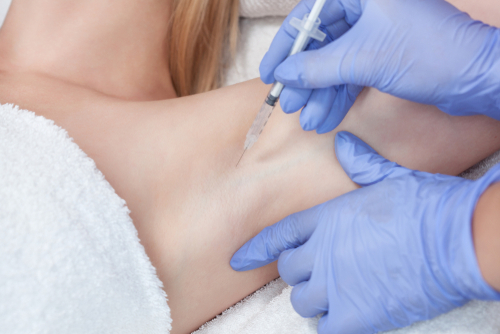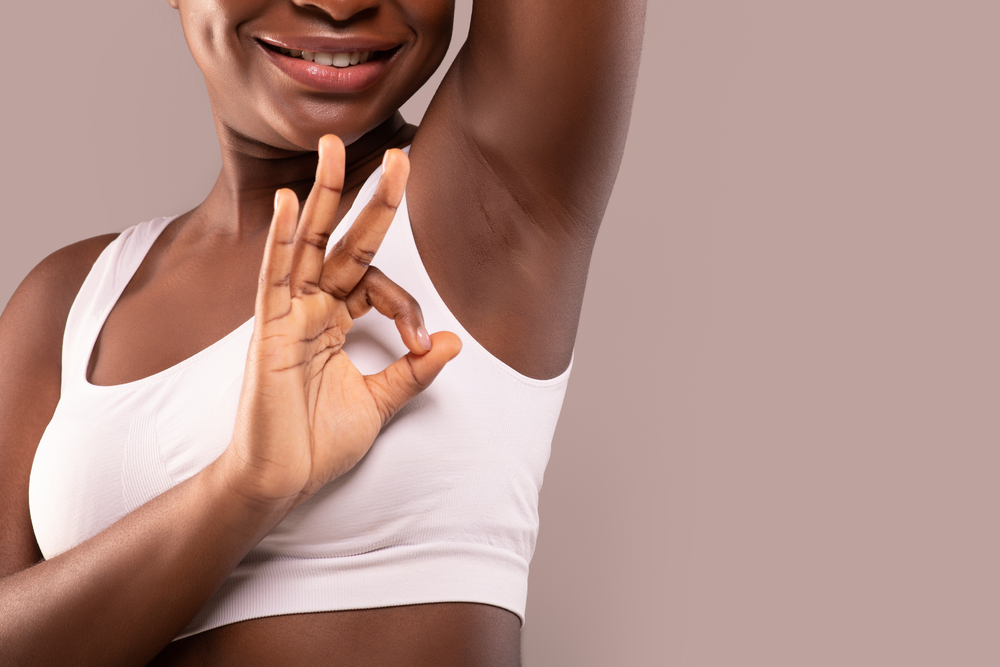What is Hyperhidrosis?
Hyperhidrosis is a condition of abnormal and excessive sweating, beyond what the body requires for cooling. Sweating is a normal and important function during times of exercise or increased temperatures to prevent overheating.
With hyperhidrosis, however, the body sweats regardless of activity or temperature. The amount of sweat is also excessive, leading to sweat-soaked clothing, slippery feet, and damp or even dripping sweat from the hands. Not only is this disruptive to daily life (imagine trying to use your phone with wet hands), but can also cause embarrassment and social anxiety.
What Causes Excessive Sweating?
Hyperhidrosis affects between 1-3% of the population. Typically beginning in childhood or adolescence, hyperhidrosis can persist into adulthood though it may not be as severe with age. Hyperhidrosis is thought to be familial.
Many patients are hesitant to speak to someone about their over sweating. Don’t be! For dermatologists, this is a common reason for visits. Adolescence and young adulthood is a time when confidence and social acceptance are especially important to patients. There are many treatment options (discussed below) that are effective, safe, and affordable. At Tennessee TeleDerm, we have many years of experience treating hyperhidrosis in teens and adults. We want to help you live your best life without the hassle of over sweating!
This blog will focus on primary hyperhidrosis, which is over sweating unrelated to other health conditions or medications.
Symptoms of Hyperhidrosis
Hyperhidrosis most commonly affects the hands (palmer), soles of feet (plantar), and underarms (axillary). These locations have more eccrine glands per centimeter than any other location on the body. Excessive sweating can also affect the scalp, face, and whole body, though these are less common.
The key to understanding hyperhidrosis is its severity. Though everyone sweats, hyperhidrosis is unrelenting to the extent that it causes secondary and tertiary skin problems like dermatitis, skin breakdown, or infection. Patients with hyperhidrosis often soak through shirts and socks and need to change clothes during the day or layer to prevent outward signs of sweat. Shoe choices are limited with plantar hyperhidrosis due to slippery soles and/or odor. The use of common household goods such as paper products and electronics becomes difficult. Fine motor activities using the hands such as writing, food preparation, and tools/instrument are also problematic.
Effects of Hyperhidrosis
Long term effects of over sweating include:
- Stained or ruined clothing
- Ruined shoes
- Chronic odor
- Skin breakdown
- Skin irritation
- Secondary fungal infections
- Sweat marks/stains left behind on paper and fabric
- Malfunction of electronics, especially handheld devices
Lifestyle modifications to consider as well:
- Loose-fitting clothing
- Avoid overly hot beverages
- Avoid spicy foods
- Exercise indoors
- Use of undershirts to protect nicer dress shirts/blouses
- Wear socks with copper or silver to prevent odor and infection
- Apply light cornstarch powder daily to feet (or groin or under breasts) to absorb excess moisture
- Use of absorbent shoe inserts to catch moisture and extend the life of shoes; replace inserts as needed
- Use of antiperspirants
When to Seek Dermatology Care
Many patients seek care after having tried everything they can to manage this condition on their own. Historically, patients were embarrassed to seek care for hyperhidrosis, but there is now more discussion of the condition and numerous options to treat it. Hyperhidrosis can be particularly damaging to self-esteem.
If you have sweating that you believe is excessive or interferes with your daily life, schedule an appointment with a dermatologist. There are effective and affordable prescription options for managing hyperhidrosis. A dermatologist can guide you toward the right treatment options for your specific needs.

Treatments
Oral and topical medications, as well as at-home and in-office procedures, may be utilized to treat your hyperhidrosis.
Prescription-strength antiperspirants
Prescription-strength aluminum chloride blocks sweat a bit more than over-the-counter preparations. However, higher concentrations of aluminum chloride can be irritating to the skin. It is best to apply them at night. Avoid application after shaving. Can be applied to the underarms, hands, and feet once daily. Often daily use is too irritating to the skin and every other day application is better tolerated.
Glycopyrrolate
Glycopyrrolate is an oral medication in the drug class called anticholinergics. Anticholinergics block the parasympathetic nervous system which is responsible for sweating. A daily dose of glycopyrrolate has been shown to reduce sweating by approximately 30-40% after 4 weeks. However, when taking glycopyrrolate, the medication doesn’t differentiate between over sweating and other activities controlled by the parasympathetic nervous system. Therefore, your dermatologist may slowly increase your dose over time to avoid unwanted side effects.
Topical glycopyrronium
This topical solution is designed to be applied directly to the skin via disposable wipe, blocking the eccrine gland activity locally in the skin. In 2018, the FDA approved for use on underarms only. It is very effective with few side effects.
Iontophoresis
An at-home procedure using low-level electrical current and solution-soaked pads to pass ions through the outer layers of skin cells. Ions temporarily block the eccrine gland activity. Some studies estimate a reduction in sweating as much as 85%. Iontophoresis is most effective on hands and feet. The machine and supplies are available with a prescription. The upfront cost can be high, but the equipment is long-lasting and treatment is effective.
Botulinum toxin injections
Botulinum toxin blocks nerve signals locally where injected. The injections are performed in-office and can significantly decrease or stop sweating for 3-6 months after a single treatment. Botulinum is metabolized and sweating resumes after this time and retreating is necessary. Injections are FDA approved for underarms, hands, and feet. Botulinum injections can be costly if not covered by insurance. They are very well tolerated with rare side effects, save some pain at the time of injection.
Each of these options is safe and effective, depending on the location of the hyperhidrosis. Treatments may be used in combination to ramp up treatment during warmer months and then scaled back during more manageable periods.
When to call Tennessee TeleDerm
As with many skin hair and nail conditions, it is best to first consult a Dermatologist or dermatology-trained Nurse Practitioner. At Tennessee TeleDerm we accurately assess your sweating and design a treatment plan that works best for you! Don’t let over sweating hold you back from getting the relief you need from excess sweat.


